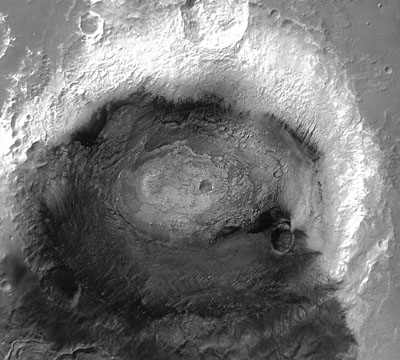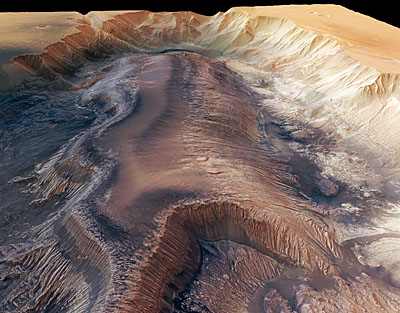[/caption]
Scientists have been intrigued and puzzled by light-toned layered deposits on Mars since the Mariner spacecraft flybys in the early 1970s. Known as LTDs (Light Toned Deposits), they are Martian sediments that most closely resemble sediments on Earth and are some of the most mysterious features on Mars. Causes for their origin remain unknown, and different mechanisms, including volcanic processes, have been proposed for their formation. But recently data and images from Mars Express suggest that several LTDs were formed when large amounts of groundwater burst on to the surface. Scientists propose that groundwater had a greater role in shaping the Martian surface than previously believed, and may have sheltered primitive life forms as the planet started drying up.
LTDs were some of the first features seen on Mars, because they showed up even in the black and white images sent back by the first spacecraft to flyby Mars. But they are also some of the least understood features on the Red Planet, and have been highly debated. These deposits occur on a large scale in Arabia Terra, Chaotic Terrain and Valles Marineris, close to the Tharsis volcanic bulge.

Now, based on Mars Express data, scientists propose that these sediments are actually younger than originally believed. Angelo Rossi and several colleagues report their findings in a paper published in September of this year in Geophysical Research. They have proposed that several LTDs may have been deposited by large-scale springs of groundwater that burst on to the surface, possibly at different times.
Analysis also indicates that ground water had a more wide-ranging and important role in Martian history than previously believed. Hydrated minerals, relatively young in age, have been found in the region.
Given that the deposits are relatively young in age, and associated with water, they may also have sheltered microbial life from the drier and harsher climate in more recent times on Mars, possibly eliminating the need for a stable atmosphere or a permanent water body.
Complimentary studies by the Mars Reconnaissance Orbiter also have indicated LTDs were formed by water.
Source: ESA


Here is an article about a laser detection technology from Idaho National Laboratory that could be used to scout for signs of life on Mars. http://www.inl.gov/laser
I’d love a geyser to blast and and clean off Spirit or Opportunity’s solar panels.
Anyone get the feeling there was water on Mars??
I hope we find a geyser somewhere!!
I cannot find the article now… but I clearly remember: Two pictures, taken from orbit, a few years apart from each other…. showing evidence of a (small-ish) flow of water during those few years. It doesn’t rain on Mars, so, those two photos seem to point at a groundwater well.
Perhaps this kind of thing happens all the time, albeit not often…?
Interestingly! Thanks!
Feenix: the two photos of the suspected water flow, after doing some computer simulations, they turned out to be likely just flows of dust. There was an article about it either here or on space.com